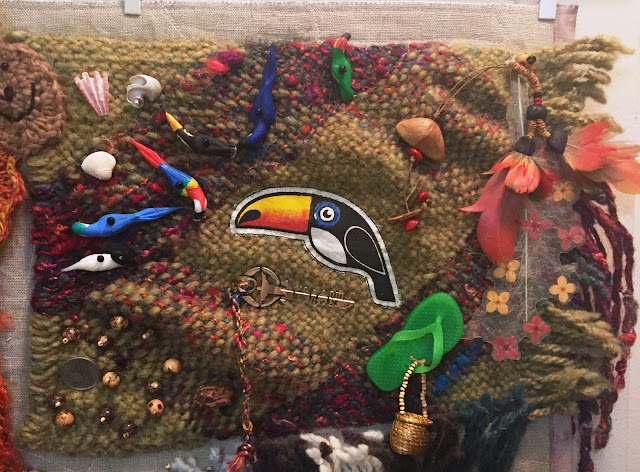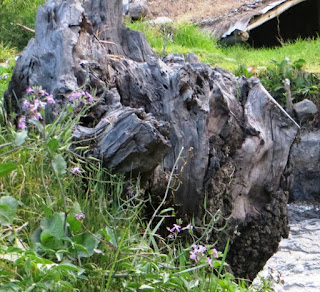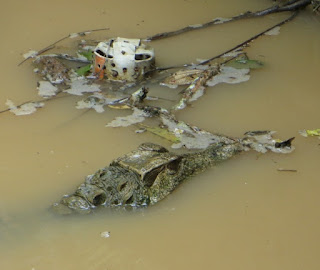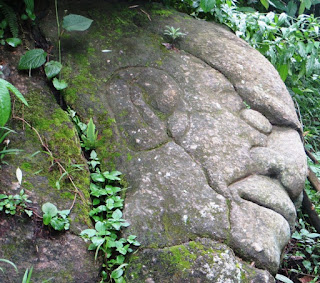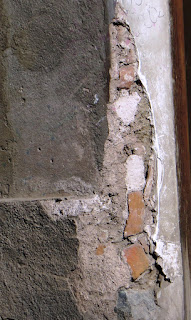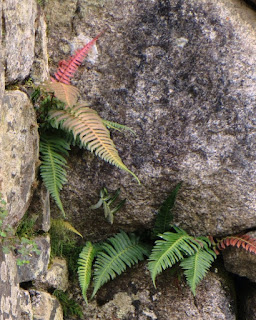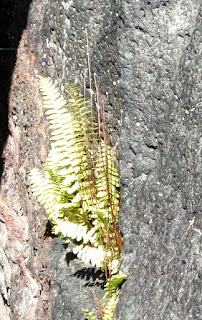We all choose ways to remember important things to be
savoured in the future. Some take
glorious photos or videos that make me feel that I am back in the
experience. One of my fellow travelers,
Maria, would present us with these great spoken word song/poems that I smile at
every time I reread them. Another
traveler, Nathan, wrote careful notes of all the details that I could never
remember and willingly shared this with all who asked. I was the one trying to
capture my memories in fiber because that is my way of mixing the sights,
smells, textures and sounds of my adventures in South America.

Although I had a broad vision of what this project would
look like, it quickly took the lead and told me where we were going. With a lot of suggestions and creative
additions, my memories of South America have become a (very) primitive crazy
quilt collage. Technically a quilt (it
does have three layers that are sewn together), but in practice it is a series
of panels to collect memories of the countries I explored in South America.
My plan was to have a finger woven square (I’m a quilter, I
think in terms of squares that come together as a whole) for each country with
colours and designs that felt like that country in some way. I also hoped to use yarn from the countries I
was passing through, which turned into a series of scavenger hunts. In practice, all the squares have touches of
the “just in case” yarns I packed from home. I was determined to use local wool or alpaca
(and hopefully some llama) and although South American ladies are definitely
knitters and crocheters, they prefer the bright coloured acrylic yarn so easily
available in shops. The structure was that each would start with the same
number of strands of yarn of the same length, thinking that would make them the
same size so they could be sewn together into a crazy afghan sort of
thing. Hmm. OK, so they weren’t the same size because of
changes in tension, different wools and even the different patterns. That was ok, I’d wait to put them together
until I got home and it would somehow come together, which it did. And somehow all the bits of memories would
work out too.
Let me introduce you to my memories of South America.
Canada
This square was finished before I left home in
February. There was a lot of buzz about
our 150th birthday year, with
the iconic colours of the Hudson’s Bay blankets everywhere. My square has all the right colours in the
correct order, and even the four points (the thin black stripes) to let you
know it is a double blanket like the one I got for a wedding present in 1975. It’s even decorated with the original label
from that blanket. I’ve added a couple
of maple leaf pins, but otherwise, this square is elegant in its
simplicity. The tension is very loose (I
learned on later squares that tighter tension meant a flatter, squarer square)
so Canada has a lot of hills and valleys. The white is wool/alpaca yarn I
bought in Alberta, but it is from Peruvian highland sheep and alpacas and is
the yarn that represents mountains in the other squares.

Settlement of Canada started with the Hudson’s Bay Company
in 1670 coming out of England, by way of the Orkney Islands of Scotland,
through the north and following the rivers in search of furs. They brought with
them, among other things, wool from the Orkneys as well as blankets in the
distinctive white with red, green, yellow and navy stripe to trade for
furs. Sometime later, the Northwest
Company out of Montreal came west along the rivers in the south, bringing their
distinctive red with black stripe blankets to trade. Whatever the colour, first nations weavers
quickly adopted the British wool to create finger woven straps/belts to be
resold to the company workers. It was the Hudson’s Bay Company that settled my
area of Northern Alberta (Alexander Mackenzie overwintered here on his way to
the Arctic one year and to the Pacific Ocean the next), so the connection of
history, home, finger weaving is all wrapped up in this square.
 |
| The label from our original blanket. Well worn but saved for just the right occasion. |
Brazil
I started Brazil just before I left home, and actually
worked on it in Grande Prairie, Calgary and Huston airports on the way to Rio
de Janeiro. Green for the Amazon
predominates although the yarn is actually lopi yarn from Iceland. Winding through is a dark blue wool from
Atlantic Canada for the Amazon itself mixed with some silk sari yarn which in
my mind represents all the glorious flamboyant costumes of Carnival. I used openfaced weaving to get the mixture
of colours. The weaving was finished and washed and hung to dry at our first
campground at Brotas on our way to the Pantanal.

The seashells are from the Flamengo beach near our hotel in
Rio. After the bloco at Copacabana
(200,000 partying Brazilians) and the crazy crowds of Carnival, it was a
delight to just beachcomb on this almost quiet family beach.I watched the key being made at the base of the Selaron stairs in Lapa. Exploring the
markets in Paraty and Bonito found some delightful bits of ephemera to add to
this square. Of course, there are assorted
birds to represent the many, brightly coloured birds I met along the way. At one of the street markets in Bonito, a man
was selling earrings of Amazon bird feathers – one makes a lovely accent in a corner
along with a sample of pressed flowers laminated to make a bookmark I found in
Paraty. Another bit is part of a seed
necklace hand made by the street vendor in a quiet parking lot in Bonito. She understood enough of my point and smile
Portuguese to be able to write down for me what plants the seeds were from. The larger beads at the bottom right were
part of the necklace with the wooden hand carved and painted birds.
Actually, all the beads on this square (and most others on
the rest of the quilt) are seeds from a variety of plants. My first thought was that a square would be
decorated only with items “from” that country, but over time I realized the
power of trade between and within countries and decided to let these seeds/beads
flow freely as well. The tiny off white
seeds that attach many items on the quilt belong to the necklace with woven
basket found in another shop in Bonito. The black seeds are from a bracelet I
bought in Arequipa, but probably they came from somewhere in the Amazon.
The single bright green sandal (thong, flip flop, jandal) is
actually a Havianna, Brazil’s iconic footwear.
I resisted the urge to purchase a pair, as my flip flops from Australia
were doing just fine. They broke our
almost last day in Bonito, which just goes to show that you need to buy a pair
of Haviannas when you visit Brazil. Looped around one of the straps is a hand
woven basket similar to baskets we saw everywhere.
Argentina and Chili
We traveled from Buenos Aires to Santiago by way of Ushuaia
and then on to Bolivia, crossing the Andes and the borders seven times. It just seemed the way to go that these two
long thin countries would be represented by two long thin panels that were made
at the same time. I set them up with
oceans on the one side, white for the mountains on the other and with slightly
different colours of land in between.
The lightening pattern, to me, just made perfect mountains and I
discovered accidentally that if you are doing the colours in different widths
that the repeat is different, making a rugged landscape. I wove from the
mountains out on each country, one row in Argentina, then one row in Chili,
which made my differences in tension spread over the entire work. Chili’s ocean, a wool from Atlantic Canada,
is repeated in the other countries that border the Pacific while Argentina’s
wool, a dark teal Icelandic lopi, is the second ocean in Columbia, where they
say they are on the Atlantic coast not the Caribbean. Because the lopi wool is
so much thicker, Argentina’s coastline is much curvier. After they were both
done, I then joined the mountains along the border. I had no luck finding Argentinean wool in
Buenos Aires, but did have a skein of hemp (spelled yempe and pronounced
Sea-shway) in a lovely red orange mix, and that became the border crossings
arranged at random from top to bottom. These squares were washed and hung to
dry in El Chalten on a beautiful sunny day when Mount Fitz Roy was smiling at
us.

We spent almost seven weeks exploring these countries, with
their wealth of different experiences.
Capturing my memories from top right (Buenos Aires) to top left (San
Pedro de Atacama) by way of Ushuaia:
Buenos Aires is an incredibly cosmopolitan city with artist
districts at San Telmo as well as around the Recoleta cemetery. A felted sunshine, hand crafted leather mask,
and earrings made of dried fruits start the journey south. Next is the wine cork from my “second grade”
organic wine that has dyed the back of the quilt. We had a number of opportunities to taste
test the various Argentinian wines. Next
is some moss (old man’s beard) and an interesting shell from the Puerto Madryn
area of Patagonia. At the southern tip
of Argentina is a sample of the lovely hand spun wool that I found by chance in
a shop in Ushuaia. Of course the wool
was from local sheep, proving that Argentina did have local wool, just not in
the big city shops. Moving up through
Chili is a bit of felted guanaco fleece with an outline embroidered with my
“mend the backpack” thread that had come in handy. This fleece was harvested from fences that we
walked past at Torres del Paine while taking a gentle walk (or as gentle as you
can get in South America where that means no more than a 300 or so meter
elevation gain or loss) the day after the big hike to the lookout. As we walked past families of guanacos, i
mentioned that it was too bad there weren’t any bushes to collect fibers from
them and wondering if I could walk carefully up to these animals, pat them and
harvest their fleece for my quilt. Both
Annette and Kate looked at me, reached over to the barbed wire fence, took off
some fleece (that I hadn’t been looking at) and handed it to me. Kate even showed her Australian ranch skills
and climbed through the fence to collect clumps of fibers from the other
side. My quilt might be the only place
in the world where you can find guanaco fleece.
 |
A handful of raw guanaco fleece,
with a bit of soap and water becomes a felted souvenir
of the wild cousins to the llama and alpaca. |
North of Torres del Paine, we spent a few days in
Pucon. Whitewater rafting one day and
then chilling out and beachcombing on the lake near our hostel found a wine
cork as well as some fascinating rocks for the quilt as well as my first
connection to the Mapuche – the fierce aboriginal group that were never
defeated by the Inka, or the Spanish, or (according to our guide) the Chilean
government. Periodically, travel is not
recommended to this area because the locals are protesting some directive of
the government and blockades and guns are often involved. When things are quiet, Pucon is an outdoor
adventure mecca with its own resident artists who were creating some
fascinating woven hangings.
In Santiago, we said goodbye to some of our group, changed
trucks and crew, and met some new people.
A few days on an estancia where we rode some beautiful retired polo
ponies, drank wine, had some incredible meals and tried our hand at roping
cows. A bit of wood and a braided rope
reminds me of the fun times. At
Calafate, while testing more wine, we first saw the huge cactuses that are used
in this desert area instead of wood for building. I had been tentatively trying to harvest a
needle from a cactus at the side of the parking lot at one winery, when Jimmy
presented me with a handful that he just happened to find. Last stop before the border was at Quilmes, a
pre Inka site, where some of us were a bit naughty and ignored the clock to finish
checking out the nooks and crannies. The
bits of pottery were “significant” said Autumn as she shared her find.
Bolivia
Bolivia was created with suggestions from some of my fellow
travelers. My choices of yarn had
multiplied in Santiago, Chili and Sas and Hannah were busily creating
friendship bracelets for everybody on our new truck, Amber. I was delighted that my fiber habit was
spreading. They were curious about what
Bolivia was going to look like, and when I confessed that I really hadn’t thought
that far, I got some great suggestions.
“It needs to be the colours of the salt flats.” Quickly three bright colours were pulled from
my stash by Sas (and agreed to by Hannah) and I added white to make streaks and
a band of chunky green from southern Chili with hand spun and dyed yarn from
Tierra del Fuego. Completely different
from Argentina and Chili, as I hoped.
Because all the yarns were thick and bulky, this square is almost square
(rather than the thinner longer rectangles of other countries). The salt flats weren’t really these colours,
but the yarn decorating the llamas and alpacas (so you knew who they belonged
to) was. So to were the bright
embroidered colours of the Aymara women’s clothing. This was finished in Uyuni.
 |
| Trying out the tiny llamas I had found in the market |
We spent a little over a week on the altiplano of Bolivia.
Uyuni, from where we visited the salt flats, was a rugged frontier town that
was a great place to check out traditional markets and where I finally found a
pair of llamas small enough to fit on my quilt.
These were actually hand made by the lady selling them. Fitting, too, is that my fellow traveler
Maria found some llama fleece. I wasn’t
sure if it was purchased, or just given to her when she visited one of the museums
in La Paz. Something about begging for
it for a friend. I used some of it to
dry felt a fluffy nest for my Kinder Surprise Amazon bird that took part in
photos on the salt flats. The bird
actually was given to me by another traveler, Andreas, in Bariloche Argentina
as a thanks for fixing his backpack. There’s also a bit of cactus wood and a cactus needle (again from Jimmy because I couldn't seem to harvest one myself) from Incahuasi
Island on the salt flats – our first brush with the Inka culture – and some
rocks and bits of ephemera from our hike on the Bolivian side of Lake Titicaca.
The multicoloured ribbon is actually the Andean flag – visible everywhere in
the Andes as a symbol of the fight for recognition by indigenous people. In Bolivia we started to see the traditional
dress on everyone as part of their daily life.
It is actually the flag of the Inka empire.
 |
| My first Kinder Surprise. Thanks Andreas. |
Peru
My idea for Peru was to create two winding paths for the
Inca Trails that our group would be hiking.
Half of our group took the Classic Trail while the rest of us trekked
the Wild Andes along a similar but less traveled route. In fingerweaving, this is a very simple
pattern so it finished quickly. I even
did a bit while camped above 4000 meters somewhere along the trail. What I found fascinating is that the pattern
I chose is actually the traditional Quechua (Inka) pattern that symbolizes the
Inka Trail. Peru is much more than just
the hike to Machu Picchu, but wherever we went there was an Inka connection.
The blue ocean on one side and the white mountains on the other are yarns that
traveled from Canada while the gold, green and adobe (my favourite colour but
also a nod at how most buildings in South America are built) alpaca is from
Chili.

You can clearly see the thin white line (of palm fibers)
which my fellow travelers suggested to represent the coca leaves we found
everywhere. Coca mate (tea) was at all
the restaurants and could be picked from bushes everywhere. Our guides on the trails carried it as a
traditional remedy for altitude sickness.
The woven llama (thank you Erin) was donated from a lovely tshirt
souvenir of Machu Picchu that didn’t want to stay attached to the shirt. Above it is a piece of yarn that I rescued
from our last campsite on the Wild Andes Trek.
We were camped in one of the village fields and sharing the space with
the village animals, and I’m guessing that one of the llamas lost a bit of its
identifying earring. The Inka Cross was a gift from our homestay at Raqchi, the
soft fleece is alpaca from an Arequipa factory (thanks again Maria) and it is
surrounded by a baby’s bracelet of seeds designed to keep away the evil
eye. I learned that these seeds actually
grew in the Amazon and you could find the bracelets everywhere . The beads/seeds
actually were from Salta (Argentina) where I had also found the Andean flag
ribbon. The condor is a replica of one
of the designs of the Nazca lines and an important part of Inka beliefs. It also is to remind me of the incredible
morning in the Colca Canyon watching the condors gliding on the updrafts, and
the great story behind one of my favourite Simon and Garfunkel songs, El Condor
Pasa, which is now the Peruvian national anthem.

Ecuador
The panel for Ecuador looks similar to Argentina/Chili but
was created at the same time rather than separately. My thought was that I was actually going to
be exploring Ecuador twice, once with Team Amber and then again on my own to
visit parts we missed. So, Ecuador has
two parts that are similar but not identical.
There’s ocean, mountains, bright colours for the birds and flowers and
more of the Icelandic green lopi yarn for the Amazon that I knew we were going
to visit the edge of with earth of a variegated brown and teal (it is wool and
acrylic, but just too soft and pretty to not bring home) to anchor them all.

Our trip through Ecuador was much quicker than I had wished,
which is why I came back for another two weeks.
Cuenca is represented by the Panama hat (what else), thanks to Annette
who also rescued a scrap of the actual weaving for the hats. The thick orange wool is hand spun and dyed
with carrots and came from a workshop we visited on our way back from
Inkapirca, a joint Inka/Canari site. The
seeds are all from a traditional village we visited on the edge of the
Ecuadoran Amazon. The wee nest is of
fibers growing on the trees and includes cocoa (pronounced CA-cow) seeds from
our workshop of how to create the best chocolate in the world. The butterfly
earring was my first introduction to Tagua, a seed of a palm tree that is
perfect for carving. Ecuador is
marketing this as environmentally friendly vegetable ivory – encouraging the
care of these trees as a renewable resource rather than burning them down.
 |
| An Inka trail sash in naturally dyed wool and alpaca yarn meanders between the country panels |
Columbia
When planning my square for Columbia, my choices of yarn
were quite limited. My stash of yarn
from Chili had been mailed home and the yarn I had found in Peru and Bolivia was
very fine alpaca. No problem. Two bands of ocean (yarn that had traveled
from Canada), a center of gold (that I had saved from Chili) and twists of bright
colours from San Pedro de Atacama and Cuzco (the threads doubled up to make
each strand thick enough). By the time I
started this, my fellow travelers were full of suggestions that got incorporated
in the final crazy quilt. Was the gold
for the Inka gold that brought the Spanish conquistadores? Or gold for all the money that Columbia’s
drug cartels made from cocaine brought from Bolivia and Peru? (Both probably) Is it possible to make a thin
white line to represent the cocaine? So,
Bolivia, Peru, Ecuador and Columbia have a thin white line meandering through
their squares made of the palm fiber used in the jungle regions to create
beaded bracelets. Joining the four
countries are some coca (cocaine) leaves created from embroidery thread I found
in Popayan in a fascinating embroidery store.

If Ecuador was all about chocolate, then Columbia is about
coffee. The beans winding their way
along the golden path were from Cafe Jesus Martin in Salento, but there were
equally great cups of coffee in Cartagena. I learned to look for “single
origin” coffee, rather than “fair trade”.
There’s shells from our stay on the Caribbean coast as well as a mussel
shell from my birthday dinner, and a pair of shell earrings from the market
(hand made by the merchant). Mompos, a
tourist town on the Magdalena river, specializes in intricate filigree
jewellery of gold and silver, a result of being the treasury for the Spanish
who stored their gold far enough from the ocean that those pesky English
pirates couldn’t easily steal it! Our journey here brought us from the cool but
wet highlands to sea level and the full heat and humidity of the north of
Columbia. A great fruit slush hand made
by the owner of a cart on the plaza was topped off by this advertisement
including email address – a hint that Columbia in many places is trying to keep
up with first world expectations. Columbia was finished during our stay at a
quirky hostel near San Gil. Peru, Ecuador and Columbia got washed and then hung to dry (with an Inka trail
sash that was gifted to my partner in the entire trip from Rio to Cartagena,
Hanna) overlooking the valley and being watched by the family goats.



Galapagos Islands
Of course the Galapagos Islands got their own panel because
I wanted to have some weaving to do while traveling on our sailing vessel, the
Beagle. I chose the colours while still
in Columbia – a dark charcoal grey that had traveled from Canada (I’d run out
of ocean blue) and doubled strands of bright pink/purple for the birds and
flowers I hoped to see. It turns out
that the Galapagos are volcanic and the background is a perfect reminder for
the sandy beaches and rugged mountains.
The pattern is actually identical to the scarf I have around my “go
adventuring” Tilley hat.

A pair of blue boobie feet earrings of tagua that I bought
at the airport and a wee penguin that Kati had brought back from her trip to
Ecuador march up the bright arrowhead path.
Mixed in are an assortment of shells from beaches we visited. The strands
of fiber at the bottom are actually from the traditional village we visited
before we arrived in Quito, but the same trees were on the Galapagos and you
could also find bracelets made of seeds threaded on these tough but pliable
fibers.
 |
| I smiled when I learned that the English "boobie" comes from the Spanish word meaning "foolish" for their courtship dance. |
Extras
When I came home and started putting all these elements
together, there were spaces that needed extra bits. At the top is a quirky sheep that I had
played with before leaving. Despite all
the sheep we saw on our travels it was the alpacas and llamas that were the
super stars who got all the attention, so this little fellow is for all the
sheep that just quietly give their fleece for export. The shells near by are
from the beach at Punta Sal, our last stop in Peru before crossing the border
to Ecuador, but they just fit better here than on Peru. At the bottom is a long and winding Inka
Trail that uses the very fine wool or alpaca yarn that I found in San Pedro de
Atacama and in La Paz and that Maria gifted me with from Cuzco.
 |
| My sheep and a friend waiting at home for a place on the memory quilt |
And the back...
It isn’t a quilt without a back and I find I have as much
fun creating the back as the front. The central panel was embroidered at home
then dyed my first day in Rio de Janiero with Brazilian coffee. I was carrying a travel filter and bought
coffee at the local market, went back to my room, brewed a cup and dipped the
fabric in. All of my fellow travelers
added their autographs, some very simply and others with a bit of poetry, or
art. The next border is dyed with wine from Mendoza – a second grade crushed
wine (that the organic winery would sell to competitors to increase their
colour) that was perfect to create a dark purple fabric but wasn’t as drinkable
as the first grade wine we sampled on our bike trip. The final bits are dyed with Columbian coffee
that I brought home to enjoy. There are
a number of the small off white beads sprinkled across the back in places where
items were sewn to the front after all the areas were together.
 |
| Yes, the Columbian coffee created a darker brown than the Brazilian coffee and the wine dyed fabric still smelled of the wine I had dyed it with in Mendoza. |
 |
| Some of the many autographs of fellow travelers. |
156 days. 7 countries. More than 70 travel companions. Here's a taste of Maria's memory of one of those important overland skills - flapping. (Chant it with a bit of a hip hop beat to it)
We
met in Rio 3 months have past
We had to learn the rules real fast
No cloth can be used to dry a pan
You just have to shake it as hard as you can
Flapping, It's called flapping
On the way we've picked up new mates
And we've taught them how to dry their plates
We flap wet dishes with all of our might
And when we're flapping we're real tight
Flapping, we love flapping
And as each of our journey ends
We'll leave behind amazing friends
The truck will have amigos new
Maybe even a different crew
But flapping, we'll always have flapping












